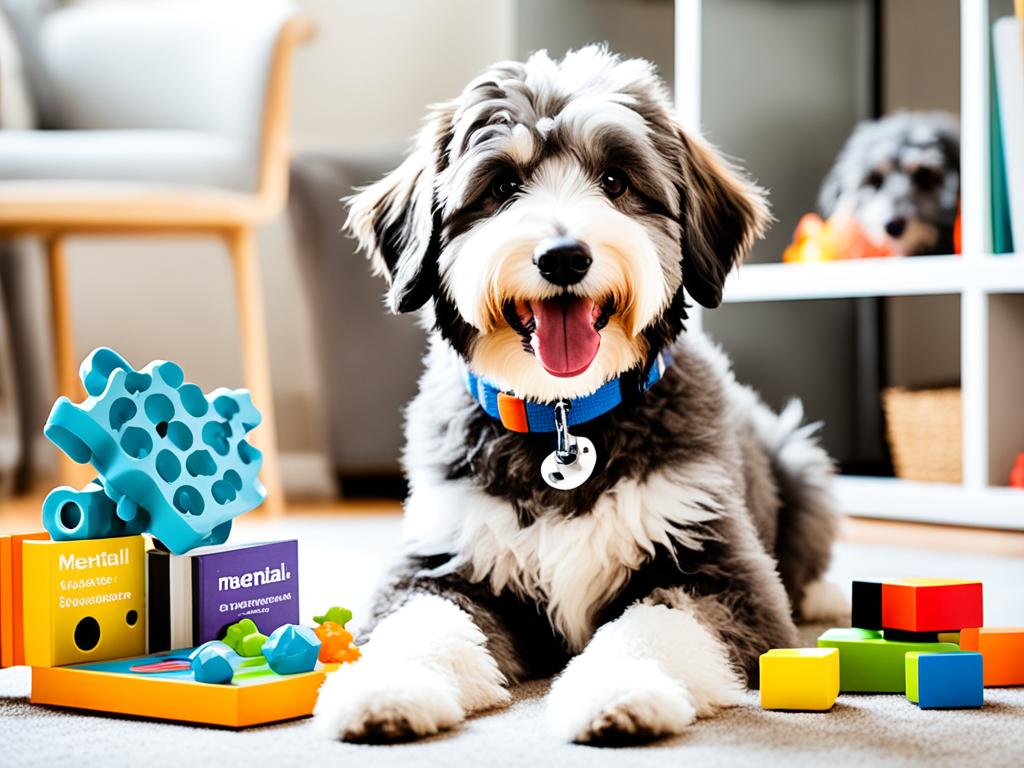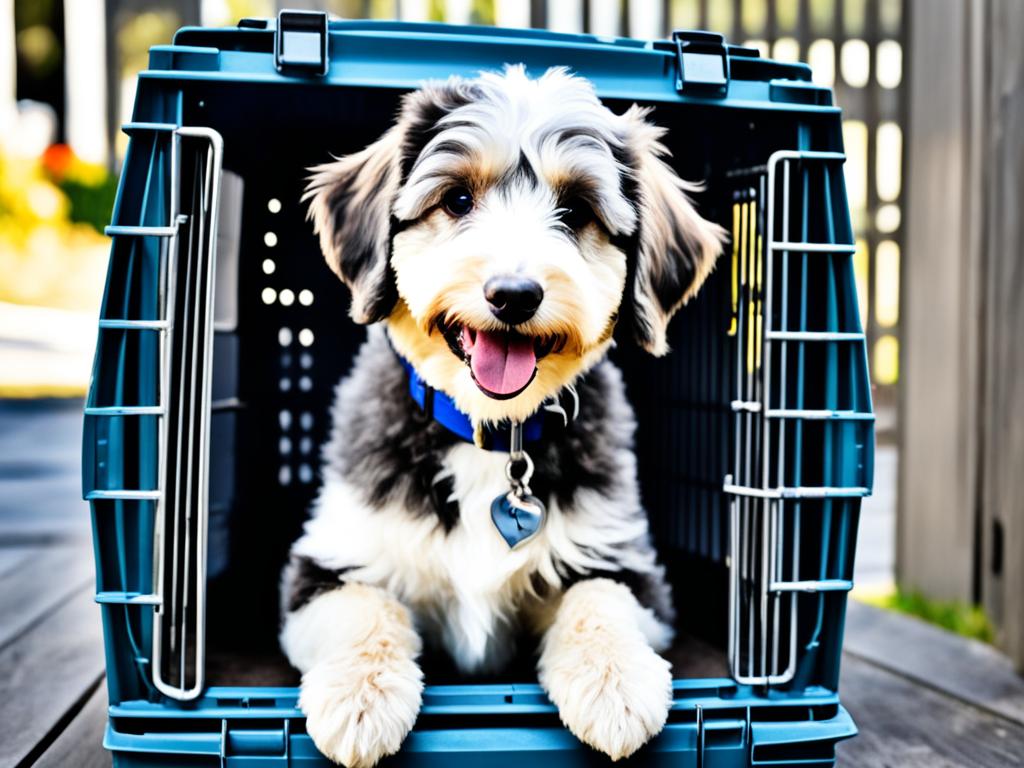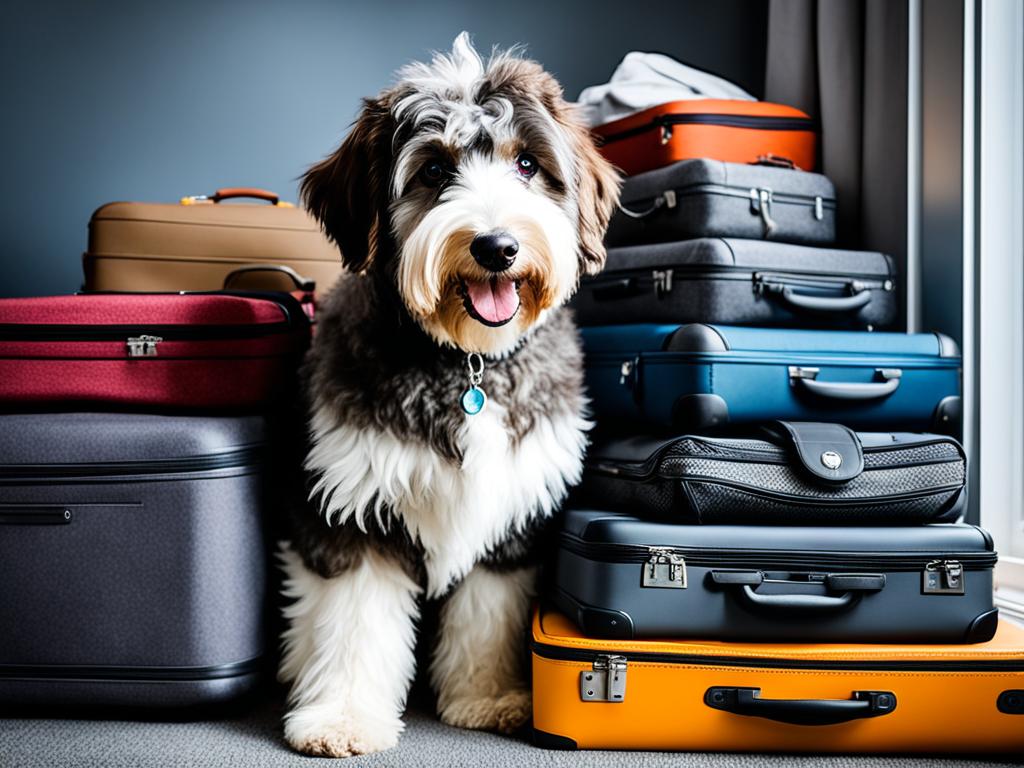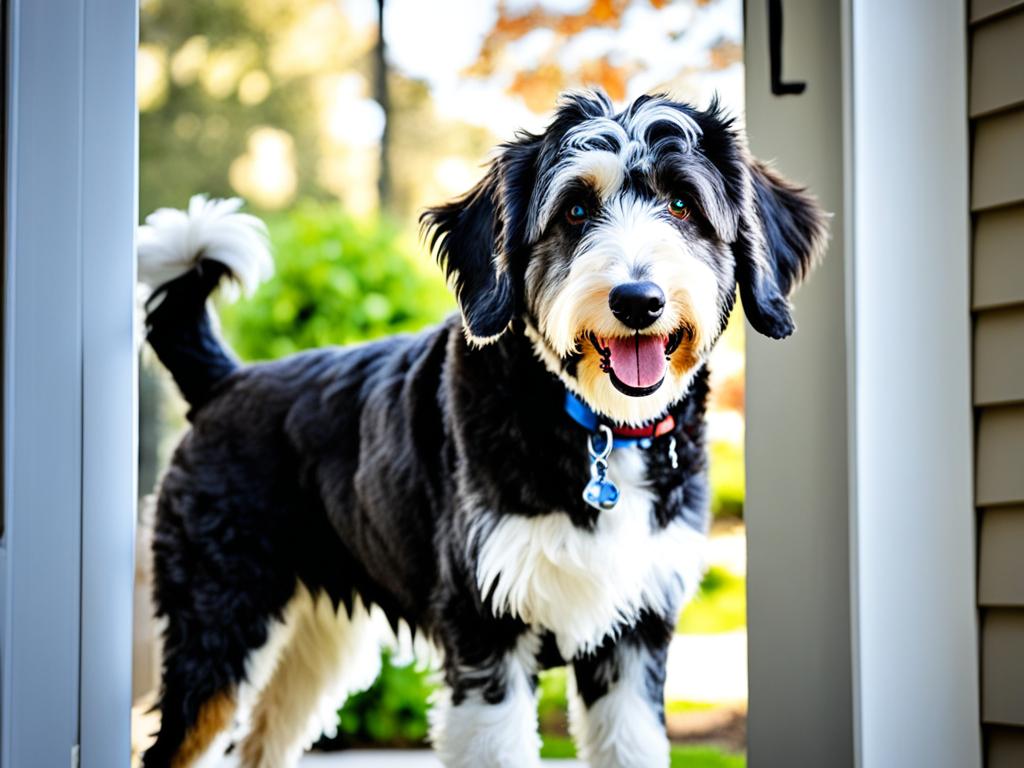Did you know that nearly 20% of Aussiedoodles suffer from separation anxiety?
Aussiedoodles are known for their friendly and sociable nature, but many owners are unaware of the challenges that come with leaving them alone. Separation anxiety can have a significant impact on both the dog and the owner’s well-being, causing stress, destructive behavior, and excessive barking.
In this article, we will explore the causes of separation anxiety in Aussiedoodles and provide effective strategies to manage and alleviate this common issue. By understanding the unique needs of Aussiedoodles and implementing proven techniques, you can create a harmonious environment and ensure the happiness of your beloved pet.
Key Takeaways:
- Separation anxiety affects nearly 20% of Aussiedoodles.
- Understanding the causes and implementing strategies is crucial for managing separation anxiety.
- Proper exercise, mental stimulation, and crate training can help reduce anxiety.
- Identifying and minimizing anxiety triggers is essential.
- Seeking professional help may be necessary in severe cases.
Why Do Aussiedoodles Have Such a High Energy Level?
Aussiedoodles are known for their boundless energy and lively nature. Understanding the reasons behind their high energy level can help pet owners effectively manage and cater to their Aussiedoodle’s needs.
Aussiedoodles inherit their high energy levels from their parent breeds, Australian Shepherds and Poodles. Australian Shepherds are renowned for their agility and herding instincts, while Poodles are known for their intelligence and athleticism. The combination of these active and athletic breeds results in the Aussiedoodle’s energetic disposition.
In addition to their genetic predisposition, Aussiedoodles have an extended puppyhood phase that contributes to their high energy levels. They maintain a youthful and playful spirit for a longer duration compared to other dog breeds. This prolonged puppyhood often means that Aussiedoodles require ample mental and physical stimulation to satisfy their energetic nature.
Managing the energy levels of an Aussiedoodle involves providing them with sufficient exercise and engagement to prevent boredom and restlessness. A well-exercised Aussiedoodle is a happier and more content companion.
| Tips for Managing Aussiedoodle Energy Levels | |
|---|---|
| 1. Exercise: | Engage in regular daily exercise sessions such as brisk walks, jogging, or playing fetch to help burn off excess energy. |
| 2. Mental Stimulation: | Keep your Aussiedoodle mentally stimulated with obedience training, puzzle toys, and interactive games that challenge their intelligence. |
| 3. Enriched Environment: | Create a stimulating environment with toys, agility courses, and playtime with other dogs to keep them engaged and entertained. |
| 4. Consistency: | Establish a routine for exercise and mental stimulation, providing a structured and predictable schedule that helps manage their energy levels. |
Note: Regular exercise and mental stimulation are key in managing the high energy level in Aussiedoodles. With the right balance of physical activities and mental challenges, pet owners can help their Aussiedoodles thrive and maintain a healthy energy level.
Controlling Aussiedoodle Energy with Exercise
Aussiedoodles are known for their boundless energy, and providing them with regular exercise is essential for managing their energy levels and promoting overall well-being. Engaging in physical activities not only helps expel their excess energy but also strengthens the bond between the owner and the dog.
There are various exercise options that can effectively tire out Aussiedoodles and keep them physically and mentally stimulated. Consider incorporating the following activities into your daily routine:
- Long walks: Taking your Aussiedoodle for long walks is an excellent way to burn off their energy. Aim for at least 30 minutes to an hour of brisk walking, allowing them to explore their surroundings and satisfy their curiosity.
- Visits to the dog park: Dog parks provide ample space for Aussiedoodles to run, play, and socialize with other dogs. This allows them to engage in high-energy activities and meet their exercise needs in a fun and interactive environment.
- Playtime in the yard: Set aside time for interactive play sessions in your yard. Use toys or play fetch to keep them engaged, encourage them to chase, and promote physical activity.
By incorporating regular exercise into your Aussiedoodle’s routine, you can help manage their energy levels and prevent behavioral issues that may arise from pent-up energy. Remember to consult with your veterinarian to determine the appropriate exercise regimen for your specific dog based on their age, health, and individual needs.
Recommended Daily Exercise for Aussiedoodles
| Activity | Duration |
|---|---|
| Long Walks | 30 minutes to 1 hour |
| Visits to the Dog Park | 30 minutes to 1 hour |
| Playtime in the Yard | 20-30 minutes |
Keep in mind that the exercise requirements may vary depending on your dog’s age, size, and overall health. Pay attention to their individual energy levels and adjust the exercise routine accordingly. Be sure to provide plenty of fresh water and allow your Aussiedoodle to rest and recover after physical activity to prevent overexertion.
Regular exercise combined with mental stimulation (which will be discussed in the following section) is key to keeping your Aussiedoodle happy, healthy, and well-balanced.
Introducing Mental Stimulation for Aussiedoodles
In addition to physical exercise, providing mental stimulation is essential for keeping Aussiedoodles engaged and content. These intelligent and active dogs thrive when their minds are challenged. Mental stimulation not only satisfies their cognitive needs but also helps to calm them down and prevent boredom-related behavior issues. Incorporating training sessions, teaching new tricks, and engaging them with interactive toys can provide the mental stimulation Aussiedoodles require.
Training Sessions
Training sessions offer an excellent opportunity to stimulate the minds of Aussiedoodles while building a strong bond with them. Teach them basic commands, such as “sit,” “stay,” and “fetch,” and gradually progress to more advanced tricks like “spin” or “play dead.” Repetition and positive reinforcement are key to successful training. These sessions not only challenge them intellectually but also improve their behavior and obedience.
Interactive Toys
Interactive toys are another effective way to provide mental stimulation for Aussiedoodles. These toys engage their problem-solving skills and keep them occupied for extended periods. Puzzle toys that require them to figure out how to access treats are particularly beneficial. Consider toys that are specifically designed to challenge their intelligence and provide a rewarding play experience.
| Benefits of Mental Stimulation for Aussiedoodles | Examples of Interactive Toys |
|---|---|
|
|
It’s important to note that mental stimulation for Aussiedoodles should be incorporated alongside physical exercise. These intelligent dogs require a combination of both to thrive. By providing mental and physical outlets for their energy, you can help ensure their overall well-being and prevent behavioral issues caused by boredom or excess energy.

By engaging in activities that challenge their minds, you can enrich the lives of your Aussiedoodles and promote a harmonious living environment. From training sessions to interactive toys, there are plenty of options available to keep them mentally stimulated and content indoors.
Signs of Separation Anxiety in Aussiedoodles
If you’re a pet owner, it’s essential to be able to identify the signs of separation anxiety in your Aussiedoodle. By recognizing these signs early on, you can take appropriate measures to manage and address the issue effectively. Here are some common symptoms of separation anxiety in Aussiedoodles:
- Excessive barking: Your Aussiedoodle may excessively bark or howl when left alone, often in an attempt to get your attention or alleviate their anxiety.
- Destructive behavior: Separation anxiety can lead to destructive behaviors such as chewing furniture, scratching doors or walls, or digging through belongings.
- Anxious behaviors: Watch out for telltale signs of anxiety, such as pacing, panting, drooling, or attempting to escape from confinement.
- Excessive salivation: Separation anxiety can cause Aussiedoodles to salivate more than usual in response to the stress of being alone.
- Toilet accidents: Some dogs with separation anxiety may have accidents in the house, despite being appropriately house-trained.
- Seeking constant attention: Aussiedoodles with separation anxiety may become clingy and demand constant attention when you’re around, making it challenging for them to cope with being alone.
If you notice any of these signs in your Aussiedoodle, it’s important to address the issue promptly and seek appropriate guidance to help them overcome separation anxiety.
Understanding your Aussiedoodle’s behavior
When it comes to separation anxiety, it’s crucial to understand that your dog’s behavior is not due to disobedience or spite. Instead, it is a result of fear and anxiety associated with being separated from their beloved owners. By recognizing these signs and responding with patience, understanding, and proper training techniques, you can help your Aussiedoodle feel more secure and comfortable when left alone.
Crate Training for Managing Separation Anxiety
If your Aussiedoodle is experiencing separation anxiety, crate training can be a valuable tool in helping them feel secure and calm when left alone. By gradually introducing the crate and making it a positive and safe space, you can create a comforting environment that reduces anxiety and promotes relaxation.
Here are some steps to successfully crate train your Aussiedoodle:
- Choose the right crate: Select a crate that is appropriately sized for your dog, providing enough room for them to stand, turn around, and lie down comfortably. Opt for a sturdy crate with proper ventilation.
- Introduce the crate gradually: Begin by placing treats or their favorite toys near the crate to pique their interest. Gradually move the treats closer to the crate and eventually inside, encouraging your dog to enter voluntarily.
- Make it a positive experience: Use positive reinforcement techniques such as praise and treats when your dog enters the crate. Associate the crate with pleasant activities like meals or quiet relaxation time.
- Provide comfort: Make the crate cozy by adding soft bedding or a familiar blanket. This will create a sense of security and comfort for your Aussiedoodle.
- Practice crate time: Start with short periods of time spent in the crate while you are at home. Gradually increase the duration as your dog becomes more comfortable. This helps them learn that being in the crate doesn’t always mean they will be left alone.
- Use a cue word: Associate a specific cue word or phrase with going into the crate. This can help your dog understand and anticipate the crate routine.
- Eliminate anxiety triggers: Remove any potential anxiety triggers from the crate area. For example, avoid leaving your dog’s collar or leash inside the crate, as these items may remind them of being left alone.
Remember, crate training should never be used as a punishment. It should be a positive and comforting space for your Aussiedoodle. Be patient and consistent throughout the training process.
Below is a table summarizing the steps for crate training your Aussiedoodle:
| Steps for Crate Training |
|---|
| Choose the right crate |
| Introduce the crate gradually |
| Make it a positive experience |
| Provide comfort |
| Practice crate time |
| Use a cue word |
| Eliminate anxiety triggers |

Minimizing Anxiety Triggers
Separation anxiety in Aussiedoodles can be triggered by various cues and routines that signal to the dog that their owner is about to leave. By identifying and minimizing these triggers, pet owners can help reduce separation anxiety and alleviate their beloved Aussiedoodle’s distress.
Recognizing Anxiety Triggers
Anxiety triggers for Aussiedoodles can vary from dog to dog, but common cues include actions like putting on specific clothing or grabbing keys. These cues signal to the dog that their owner is preparing to leave, which can induce anxiety. By observing their dog’s behavior and identifying these triggers, pet owners can take steps to minimize their impact.
Desensitizing the Dog
Desensitization is a technique that involves gradually exposing the dog to the anxiety-triggering cues in a controlled and positive manner. By creating a safe and calm environment, pet owners can introduce the triggers and associate them with positive experiences, such as treats or playtime. Over time, the dog will become less reactive to these cues and develop a more relaxed response.
Mixing Up Routines
Aussiedoodles are intelligent dogs who thrive on routine, but a predictable routine can also contribute to separation anxiety. By mixing up daily routines, such as changing the time of walks or feeding, pet owners can help desensitize their dog to the cues that precede their departure. This unpredictability can reduce the dog’s anticipation and anxiety surrounding their owner’s absence.
Gradual Increase in Alone Time
Another effective strategy is gradually increasing the amount of time the dog spends alone. Starting with shorter durations and gradually building up to longer periods allows the dog to acclimate to their owner’s absence at a manageable pace. This gradual exposure can help minimize anxiety and build the dog’s confidence in being alone.
Visualizing Comfort and Security
Creating a safe and comfortable environment for the dog while they are alone can help minimize separation anxiety triggers. Provide interactive toys, background noise, and a designated space for relaxation. These elements can help the dog feel secure and occupied while their owner is away. Positive reinforcement, such as leaving treats or toys for the dog to discover, can also contribute to their comfort and sense of well-being.
By paying attention to anxiety triggers, desensitizing the dog, mixing up routines, gradually increasing alone time, and creating a safe environment, pet owners can take proactive steps to minimize separation anxiety triggers in their Aussiedoodles. These strategies can promote a sense of calm and well-being for both the dog and their owner.

Seeking Professional Help for Severe Cases
In severe cases of separation anxiety in Aussiedoodles, it may be necessary to seek professional assistance from a certified trainer or veterinary behaviorist.
Professional help can provide invaluable guidance and support to address the underlying causes of separation anxiety and develop effective strategies for managing and alleviating these issues in your Aussiedoodle.
A veterinary behaviorist is a specialized professional who has advanced training in animal behavior and can offer expert advice on managing separation anxiety in Aussiedoodles.
They have a deep understanding of the complexities of canine behavior and can provide specialized training techniques tailored to your dog’s individual needs.
In addition to training techniques, a veterinary behaviorist may also recommend medications or other therapeutic interventions to help your Aussiedoodle cope with and overcome separation anxiety.
By working closely with a professional, you can have peace of mind knowing that you are providing the best possible care and support for your furry friend.
If you believe your Aussiedoodle is experiencing severe separation anxiety, don’t hesitate to reach out to a certified trainer or veterinary behaviorist for professional assistance.

Creating a Safe and Comfortable Environment
When it comes to managing separation anxiety in Aussiedoodles, creating a safe and comfortable environment for them is essential. By providing the right conditions, you can help alleviate their anxiety and promote a sense of security. Here are some tips to ensure a safe and comfortable space for your furry friend:
Interactive Toys
Interactive toys can be a great way to keep your Aussiedoodle mentally stimulated and engaged, even when you’re not around. Toys that dispense treats or challenge their problem-solving abilities can help distract them from the stress of being alone. Be sure to choose toys that are safe and appropriate for your dog’s size and chewing habits.
Background Noise
Background noise can create a soothing atmosphere for your Aussiedoodle when they’re home alone. Leaving a radio or TV on at a low volume can help mask external sounds and provide a sense of company. Consider playing calming music or using specific soundtracks designed for dogs to help promote relaxation.
Designated Relaxation Space
Having a designated relaxation space can give your Aussiedoodle a sense of security and comfort. Set up a cozy corner or provide a comfortable bed or blanket in an area where they feel safe. Make sure the space is away from any noises or distractions that might cause stress.
Gradual Increase in Alone Time
Gradually increasing the amount of alone time your Aussiedoodle experiences can help them build confidence and reduce separation anxiety. Start with short periods where you leave them alone and gradually increase the duration over time. Use positive reinforcement and rewards to create a positive association with being alone.
By implementing these strategies, you can create a safe and comfortable environment for your Aussiedoodle, promoting their well-being and reducing separation anxiety.
| Benefits of a Safe and Comfortable Environment | How It Helps with Separation Anxiety |
|---|---|
| Reduces stress and anxiety | Provides a sense of security |
| Keeps them mentally stimulated | Prevents boredom and destructive behavior |
| Promotes relaxation and calmness | Helps them stay calm when left alone |
| Builds confidence and independence | Encourages gradual increase in alone time |
Preparing for Changes in Routine
As pet owners navigate changes in their daily routines, it’s essential to consider how these adjustments can impact our beloved Aussiedoodles. These intelligent and affectionate dogs thrive on predictability and structure, so adapting to new schedules requires a thoughtful approach to prevent separation anxiety.
Gradual acclimation is key when preparing Aussiedoodles for changes in routine. Start by making small adjustments to their daily schedule, such as gradually shifting meal times or exercise routines. This approach allows them to become familiar with the upcoming changes and minimizes stress and anxiety.
In addition to gradual adjustments, it can be beneficial to enlist the help of professionals such as dog sitters, dog walkers, or doggy daycare. These services provide companionship and mental stimulation throughout the day, helping to ease the transition for Aussiedoodles.
Consistency is crucial during this period of adjustment. Maintaining a consistent routine for exercise and mental stimulation helps Aussiedoodles feel secure and less anxious. Set aside dedicated time each day for activities such as walks, interactive play, and training sessions to provide structure and keep their minds engaged.
Remember, flexibility is essential when adjusting to new schedules. Unexpected events may disrupt planned routines, but adopting a calm and adaptable mindset will help maintain a sense of stability for your Aussiedoodle. Embrace change with a positive attitude, and your furry friend will follow suit.
To summarize, gradually introducing changes, seeking professional help if needed, and maintaining consistency are key strategies for helping Aussiedoodles adjust to new schedules. By implementing these approaches, pet owners can promote a smooth transition and prevent separation anxiety in our beloved companions.
Building a Strong Bond and Consistency
When it comes to managing separation anxiety in your Aussiedoodle, building a strong bond and maintaining consistency in training are key. By focusing on positive reinforcement, consistent training sessions, and providing a balanced lifestyle, you can help reduce your Aussiedoodle’s separation anxiety.
Positive reinforcement involves rewarding your dog for good behavior, such as following commands or exhibiting calm behavior when left alone. This can be done through treats, praise, or playtime. By reinforcing positive behaviors, you can strengthen the bond between you and your Aussiedoodle and boost their confidence.
In addition to positive reinforcement, consistent training is essential. Establishing a routine and enforcing boundaries can give your Aussiedoodle a sense of structure and security, helping them feel more comfortable when alone. Consistency in commands, expectations, and daily activities can also contribute to their overall well-being and reduce anxiety.
Alongside building a strong bond and consistency in training, it’s important to provide your Aussiedoodle with a balanced lifestyle. This includes ensuring they receive proper nutrition and exercise tailored to their needs. Regular physical activity, mental stimulation, and socialization can help drain your dog’s energy and promote a healthy state of mind.
FAQ
How can I manage separation anxiety in my Aussiedoodle?
Managing separation anxiety in Aussiedoodles involves providing physical and mental stimulation, recognizing the signs of anxiety, crate training, reducing anxiety triggers, seeking professional help if needed, creating a safe environment, preparing for changes in routine, and building a strong bond through consistency.
Why do Aussiedoodles have such a high energy level?
Aussiedoodles inherit their high energy level from their parent breeds, Australian Shepherds and Poodles. Additionally, their extended puppyhood phase contributes to their energetic nature.
How can I control my Aussiedoodle’s energy through exercise?
Regular exercise is essential for controlling energy levels in Aussiedoodles. Long walks, trips to the dog park, and playtime in the yard can help tire them out and strengthen the bond between owner and dog.
How can I provide mental stimulation for my Aussiedoodle?
Mental stimulation is crucial for Aussiedoodles’ mental well-being. Training sessions, teaching new tricks, and interactive toys can help satisfy their mental needs, keep them engaged, and calm them down.
What are the signs of separation anxiety in Aussiedoodles?
Signs of separation anxiety in Aussiedoodles include excessive barking, destructive behavior, and anxious behaviors like pacing or drooling. Recognizing these signs early on can help address the issue effectively.
How can crate training help manage separation anxiety in Aussiedoodles?
Crate training can be an effective tool in managing separation anxiety. Introducing the crate slowly, making it a positive and safe space, and gradually increasing the time spent in the crate can reduce anxiety and provide comfort when the dog is left alone.
How can I minimize anxiety triggers for my Aussiedoodle?
Paying attention to triggers that cause anxiety, such as getting dressed or picking up keys, and desensitizing the dog to these cues can reduce separation anxiety. Mixing up routines and gradually increasing alone time can also alleviate anxiety.
When should I seek professional help for separation anxiety in my Aussiedoodle?
If the separation anxiety is severe and persists despite efforts to manage it, it’s advisable to seek help from a certified trainer or veterinary behaviorist. They can provide specialized training techniques, medications, and support to address the underlying causes of separation anxiety.
How can I create a safe and comfortable environment for my Aussiedoodle?
Providing a safe and comfortable environment involves offering interactive toys, background noise, and a designated space for relaxation. Gradually increasing alone time and using positive reinforcement can also contribute to the dog’s comfort.
How can I prepare my Aussiedoodle for changes in routine?
When transitioning to new routines, such as returning to the office, gradually acclimating the dog to the changes can help prevent separation anxiety. Utilizing dog sitters, dog walkers, or doggy daycare and maintaining a consistent routine for exercise and mental stimulation can ease the transition.
How can I build a strong bond with my Aussiedoodle and ensure consistency?
Building a strong bond involves positive reinforcement, consistent training, and providing a balanced lifestyle with proper nutrition and exercise. Consistency in training and enforcing boundaries can contribute to the overall well-being of the dog.

Leave a Reply